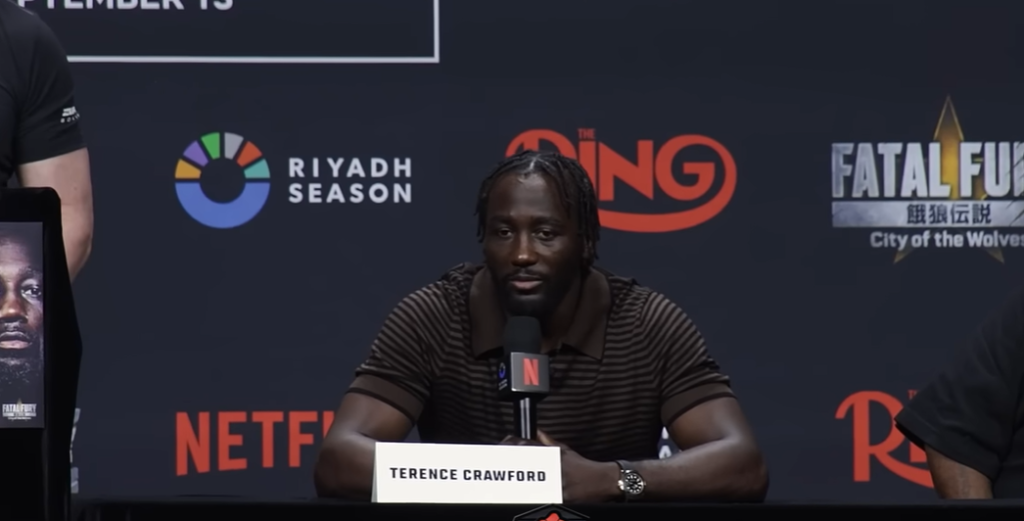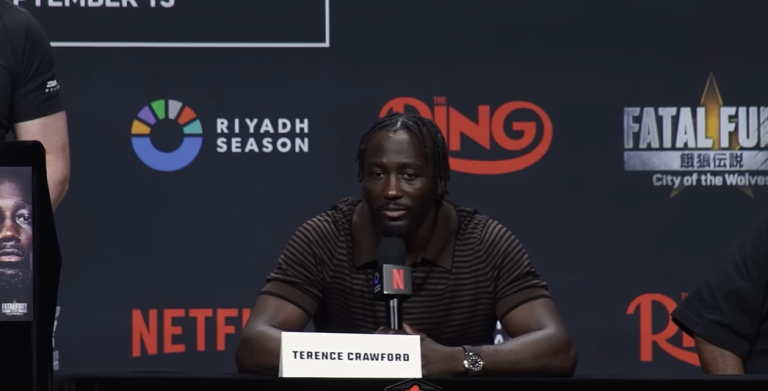| Full Name | Terence Allan Crawford |
|---|---|
| Nickname | Bud |
| Date of Birth | September 28, 1987 |
| Age (2025) | 37 |
| Birthplace | Omaha, Nebraska, USA |
| Nationality | American |
| Occupation | Professional Boxer |
| Division | Lightweight, Junior Welterweight, Welterweight |
| Titles Held | WBO, WBA, WBC, IBF (multiple divisions) |
| Fights (2025) | 41 wins, 0 losses |
| Spouse / Partner | Alindra Person |
| Children | 6 |
| Estimated Net Worth | $20 million |
| Reference Source | www.celebritynetworth.com |
Beyond punches and paychecks, Terence Crawford’s financial legacy in boxing demonstrates strategic thinking, incredible stamina, and unwavering excellence. Crawford’s total career earnings have surpassed $51 million, and as of 2025, his estimated net worth is $20 million. Crawford is one of the most financially viable boxers in the modern era thanks to these numbers, which have been significantly raised by a string of high-profile title fights and pay-per-view deals.
Growing up in Omaha, Nebraska’s rough neighborhoods, Crawford’s story started with tenacity rather than luxury. For the majority of his early years, his father was incarcerated, so his mother had to steer the family through difficult times. Terence discovered boxing when he was seven years old, and it soon became a goal. Although early sparring sessions were frequently overly strenuous, they helped to create a fighter with unwavering determination and grit.
Crawford’s ascent through the boxing ranks over the last ten and a half years has been especially remarkable. He never looked back after becoming a professional fighter in 2008 and winning the WBO lightweight title in 2014. In addition to becoming the undisputed junior welterweight champion, he recently became the first male boxer to win all four major titles in two different divisions by winning the welterweight title. In a sport where legacy frequently varies with popularity, that exceptional accomplishment makes him stand out.
Crawford’s path has also been incredibly cost-effective. He won $1.21 million in February 2016 after defeating Hank Lundy. A few months later, he earned $1.3 million after defeating Viktor Postol. His income and reputation were steadily increased with each battle. Crawford earned $3 million in 2018 after defeating Jeff Horn to win the WBO welterweight title. He earned $3.625 million from his fight against Jose Benavidez Jr. later that year, demonstrating that his brand was starting to make money even without the bombast that other fighters depended on.
A series of lucrative bouts ensued, including the 2019 Amir Khan fight, which brought in $5.5 million, the 2020 Kell Brook fight, which brought in $4 million, and the 2021, fiercely contested fight against Shawn Porter, which brought in $6 million. But what garnered media attention was his bout with Errol Spence Jr. in July 2023. It was the most profitable event of his career in addition to being a fight for all four major welterweight titles. When PPV bonuses and guarantees are taken into account, Crawford reportedly made $25 million.

Crawford continues to be a figure of remarkable durability in a sport that is frequently dominated by volatility by holding an undefeated record of 41 wins and 0 losses. He has proven particularly challenging to defeat due to his southpaw stance, incredibly sharp counters, and remarkable ability to adapt in the middle of a fight. He is often described by analysts and fans as a master strategist who can study an opponent for two rounds before dominating from the third on. These attributes not only lead to wins, but they also fetch high prices.
Crawford’s alliances have been especially helpful outside of the ring. In addition to his more recent agreements with clothing and lifestyle brands, his long-standing partnership with Everlast offers a steady source of income. He has also made subtle allusions to real estate endeavors in Omaha in recent years, making investments in homes that support his long-term financial stability objective. He has increased his financial base through strategic alliances without the publicity that many athletes experience.
Crawford doesn’t strive for tabloid or social media fame like some of his peers, such as Ryan Garcia or Gervonta Davis. Performance and legacy have continued to be his main priorities. Despite being less ostentatious, that focus has proven to be very successful. He has established a foundation that helps the neighborhood as well as his personal life. His impact is profound in Omaha. Crawford uses his position to encourage self-control and resiliency by frequently mentoring young fighters and providing funding for initiatives for young people who are at risk.
His role as a father to six children adds even more interest to his story. Interviews indicate that becoming a father changed his goals from proving himself to securing a future. He has been open about how having a family changed his perspective and made him fight for stability and opportunities for future generations rather than just for titles. His calm, collected manner both inside and outside the ring reflects that attitude.
In debates about the top pound-for-pound fighters, Crawford’s name is frequently brought up and he is frequently contrasted with Floyd Mayweather, Manny Pacquiao, and Canelo Álvarez. Crawford is unique, though, not just because of his record but also because of how he has attained it. He has subtly created an incredibly resilient legacy without resorting to public spectacle. He establishes a model that is both professionally and profoundly human by letting his record and discipline speak for themselves.
The prospect of a confrontation with Canelo Álvarez looms large. If it takes place, it might easily be his most lucrative fight to date, bringing his total earnings over $75 million. Even if it doesn’t come to pass, Crawford’s legacy is unblemished. He has already revolutionized the sport by demonstrating that focus, humility, and a dedication to excellence can yield financial rewards just as great as bluster and controversy.


